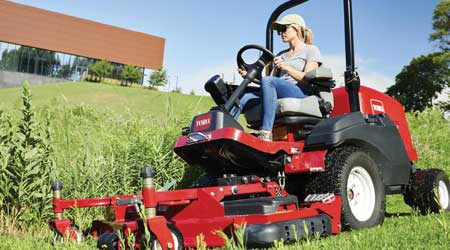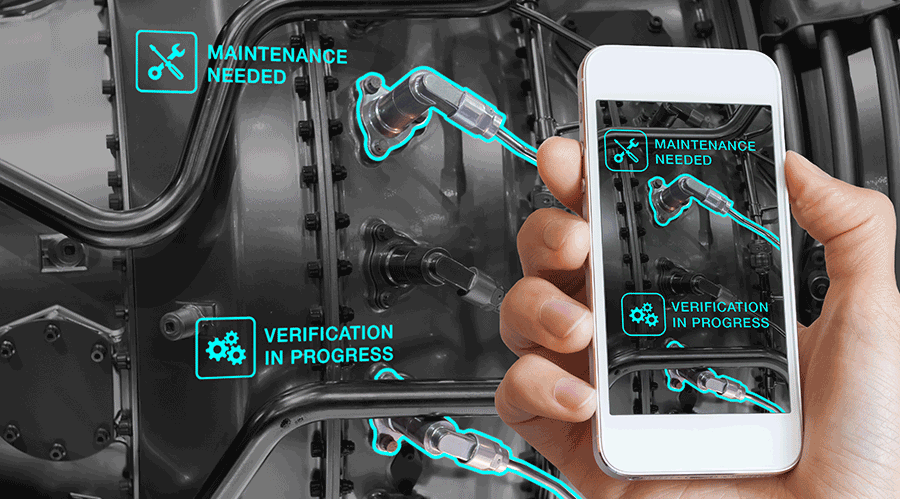 Mower selection tends to focus on finances and performance, but managers also need to pay close attention to two issues that relate to equipment operators – safety and ergonomics.The Toro Co.
Mower selection tends to focus on finances and performance, but managers also need to pay close attention to two issues that relate to equipment operators – safety and ergonomics.The Toro Co. Consider Fuel Efficiency, Total Life-Cycle Costs in Mower Selection
It's often difficult to move beyond first-cost in mower selection, but managers should also consider all the costs that go into a mower's total cost of ownership.
Fuel considerations have risen on the priority lists of many managers as they search for greater efficiency related to gasoline-powered mowers and new models powered by alternative fuels.
“Electronic fuel-injected (EFI) power has been growing at a steady pace,” Schoenthaler says. “Unlike propane, EFI offers reduced fuel usage, dependable power and reduced engine exhaust emissions. Other benefits include reliable hot- and cold-weather starts because there is no choke. There’s no messy, gummed-up carburetor to clean and adjust. Advanced oxygen sensors analyze the air/fuel mixture, making adjustments as needed. These engines are capable of saving up to 25 percent fuel over similar-size carbureted engines. This results in longer runs and fewer fuel stops and, of course, fuel savings.”
Diesel-powered mowers remain popular options for managers who put a premium on fuel efficiency
“Fuel costs are tough to predict because the supply and demand affects the prices on a daily basis,” Schoenthaler says “Take into consideration the efficiency and horsepower of the engine. The most fuel-efficient engine is the diesel that only consumes on average one gallon per hour. The engine in a diesel-powered mower is easier to maintain and delivers more torque to power through heavy, wet grass at faster mowing speeds, thus increasing productivity.”
For managers in the market for mower fuel sources beyond gasoline and diesel, battery-powered models have become more popular options in recent years.
“Being electric, you pay a little of a premium upfront but you’ve in essence, pre-paid for your fuel,” says Chad Winters, product manager for vehicles and robotics with Greenworks Commercial. “The cost to charge a battery is negligible. On top of that, we have removed the wear parts like belts and pullies, which add up over the life of a traditional mower. Battery life cycles are thousands of cycles, so even for a commercial user, it’s years of use.”
Closing the deal
For many managers traditionally focused on the initial cost of a mower, perhaps the most challenging task in making a final selection is determining a product’s life-cycle costs, though a growing number of managers seem to have made the switch.
“The industry has become very smart when it comes to total cost, Winters says. “They no longer just look at the sticker price. Many realize fuel cost and lifespan maintenance costs when it comes to a purchase.”
The process involves understanding the cost associated with items that go beyond a mower’s size, speed and power.
“Service support is incredibly important,” Vachal says. “Managers must be able to quickly get parts and service when they need them to keep their teams running. Finding the right dealer to service and support your team is key.”
Adds Scheffler, “Managers should review the warranty and look at the associated hours to the mowers in question. A warranty with higher hours specified may correlate to longer cycle times on the product and features of the mower by the OEM, which can mean more confidence in a longer mower lifespan.”
A mower’s versatility also can play a large part in the contribution it makes to the productivity of the operator and the department.
“We also see facilities expecting multi-function from their mowers – year round use if possible,” Winters says. “This will allow operators to use powered and non-powered implements on their zero-turn mowers, making them multi tools for an owner.”
Truly maximizing the investment in a mower can even extend beyond its performance life.
“When a purchase decision is being made, be sure to check which brands carry better trade-in value,” Schoenthaler says. “This will be important when it’s time to trade in the mower. Work closely with the dealer to identify the optimum hours to run the mower before trading it in. Having a good maintenance record will increase the value of the used mower.”
For all of its challenges and complexities, the mower selection has become easier for overworked managers thanks to the availability of information via enhanced connectivity to manufacturers and peers with experience in the process.
“The internet has given purchasers information at their fingertips,” Winters says. “Many times, they have done the homework and know what they want. They are shopping for the place to buy it. They are looking for a full-line dealer that carries all the products. They also want to know what other innovative products are available that may be able to help them get the job done.”
Dan Hounsell is editor of Facility Maintenance Decisions.
Related Topics:














